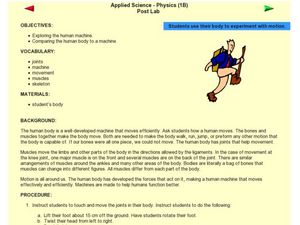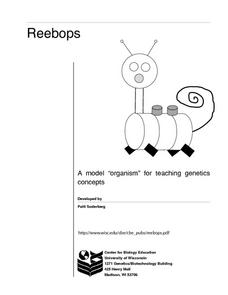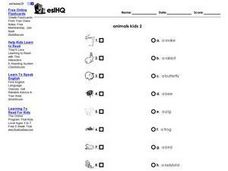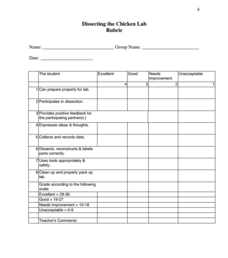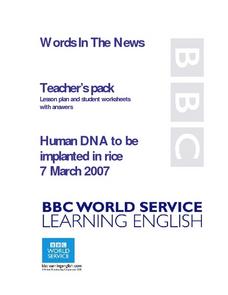Curated OER
Human Machine
Students explore the human body by conducting an exercise in class. In this human anatomy lesson, students view a diagram of the human body and identify the specific bones and joints that allow us to perform specific exercises like...
Curated OER
Guess Who? Coral
Fourth graders identify and group coral formations. In this coral identification lesson, 4th graders examine coral pictures, discuss vocabulary, and provide similarities and differences in the growth formations.
Curated OER
Will Smog be a Problem at the Olympic Games?
Students locate China on a world map, then read a news article about pollution in Beijing. For this current events lesson, the teacher introduces the article with a discussion about smog and a vocabulary activity, then students read the...
Curated OER
Natural Selection and Evidence Worksheet
Matching and fill-in-the-blank exercises give biology whizzes a chance to practice vocabulary associated with evolution. Terms to be reviewed focus on evidence for evolution, natural selection concepts, and some genetics words. You could...
Curated OER
Breathing
In this breathing worksheet, students will review vocabulary words and topics relating to the lungs and the parts of the breathing system in humans. Students will explore how exercise effects the carbon dioxide that is exhaled. This...
Curated OER
Reebops a Model "Organism" for Teaching Genetics Concepts
Reebops are cute, marshmallow-based creatures that can be used to teach inheritance. Beginning biologists draw strips of paper that represent chromosomes from two envelopes, one for the father, and one for the mother. Each parent...
Knoxville Art Museum
Lee Walton: Codes in Drawings
Familiar with the systems-based sports drawing of experimental artist Lee Walton? If so, this drawing exercise if for you. Young artists observe an activity over time, develop a coded language for the activity, and then draw a...
Curated OER
Animals Kids 2
In this vocabulary worksheet, students match the names of ten animals with their illustrations. The worksheet is intended to be used with English language learners.
Curated OER
Animals 3
In this vocabulary worksheet, students match the names of ten animals with their pictures. The worksheet is intended to be used with students who are learning English.
Curated OER
Animals 4
In this vocabulary activity, students draw lines to match the ten animal names to their pictures. The activity is intended to be used with students who are learning English.
Curated OER
Hardy-Weinberg Equilibrium According to Hoyle: OR, Population Genetics or Platypapyrus foursuitii
Students use this exercise to help achieve a working knowledge of the Hardy-Weinberg Equilibrium without recourse to algebra. After participating in this activity, students gain a feeling for the significance of the Hardy-Weinberg...
Curated OER
Skeletal Structures
Students relate the location and the function of individual skeletal parts. Students identify and discuss skeletal differences between species. Students identify and define related terminology. Students individually complete a written...
Curated OER
Phases of Matter
Eighth graders practice using correct vocabulary and apply content knowledge related to phases of matter when answering questions about situations or observations from everyday life.
Curated OER
EXPLORING OUR HUMAN BODIES
Students observe and investigate the human skeletal and muscle systems. They become aware of the versatility of movement as well as gain experience through the use of diagrams and hands on activities. An extensive vocabulary is covered...
Curated OER
Words in the News-Human DNA to be Implanted in Rice
Students examine new vocabulary words from a news report about human DNA being implanted in rice and grown in Kansas. Students read the article and discuss the vocabulary terms as well as take a quiz and complete a worksheet to help...
Curated OER
Comparing and Contrasting
Students practice compare and contrast skills. In this science and language development lesson, students complete a T chart generating traits of a snail and a clam. Students complete a related worksheet.
Curated OER
The Dynamic Earth
Students participate in assessments related to the layers of the Earth. They read chapters of text, answer questions, watch videos, and identify and label continents and oceans on a map. They design posters, create vocabulary cards,...
Curated OER
El Niño and it's Impact on the World
Students explore the causes of El Niño. In this series of earth science lesson, students research the consequences of this weather phenomenon. They recommend ways to prepare for this disaster.
Curated OER
Exploring Today's Technology
Second graders explore technology. In this science instructional activity, 2nd graders discuss various forms of technology. Students research technology that they use everyday and write a sentence about each one of the technologies.
Curated OER
Physics and the Quantum Mechanical Model
For this physics worksheet, students review vocabulary terms and key equations associated with the quantum mechanical model. Students apply the quantum theory to explain the photoelectric effect. This worksheet has 5 true or false, 12...
Curated OER
Learning the Dissecting Planes
Middle schoolers explore dissecting planes. For this biology lesson plan, students learn the basic vocabulary used in dissection, learn how to orient themselves on a three dimensional figure, and develop the manual dexterity necessary to...
Curated OER
Water: A precious resource
In this water activity, students watch a video on water, read a passage, complete sentences, write vocabulary words, and write a paragraph. Students complete 5 activities total.
Curated OER
Turtle Hurdles
Students explore physical education by researching biology. In this survival techniques lesson, students discuss the methods turtles use to survive dangerous encounters and conduct a sea turtle role play exercise. Students identify the...
Curated OER
It Ain't Easy Being Green!
Pupils explore the needs of plants. In this science lesson, students plant seeds and place one in a sunny spot and the other in a dark area. Pupils observe what happens.


